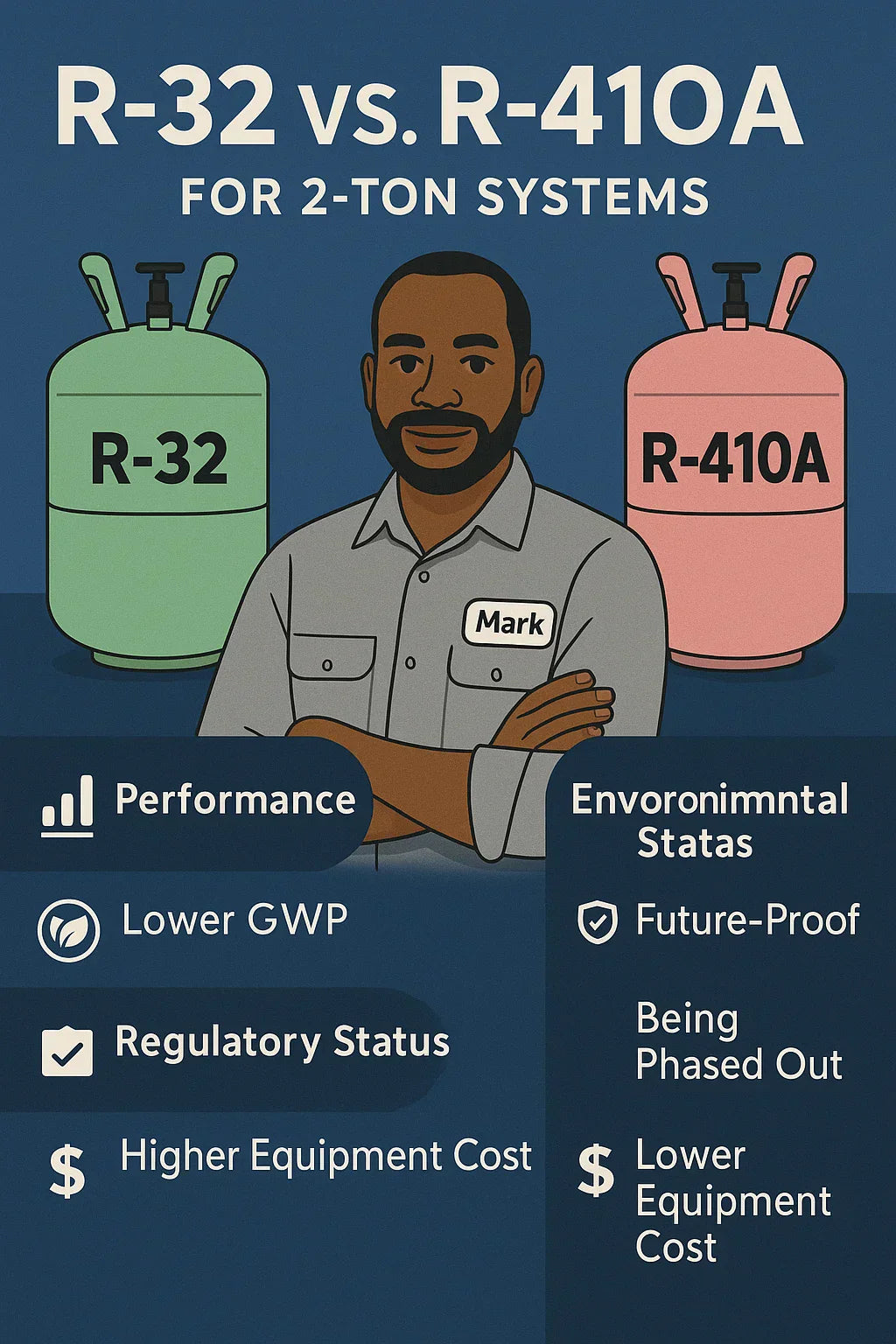⚡ Why Understanding Refrigerant Matters
When planning your HVAC upgrade, the choice between R-32 and R-410A affects not only your home's comfort but also your environmental impact, energy efficiency, and long-term maintenance costs. For homeowners like Mark Callahan, understanding this difference helps in making a future-proof investment.
❄️ What Is R-410A?
R-410A, commonly branded as Puron, has been the industry standard refrigerant for residential AC systems for over two decades. It replaced R-22 (Freon) due to its ozone-friendly composition and offers reliable performance.
Key Characteristics:
-
Zero ozone depletion potential (ODP)
-
Global Warming Potential (GWP) of 2,088
-
Requires higher pressures in HVAC systems
-
Readily available with widespread technician familiarity
Learn more:
🌱 What Is R-32?
R-32 is a newer refrigerant now adopted in many systems due to its lower environmental impact and high efficiency. It is a single-component refrigerant, making it easier to recycle and handle during servicing.
Key Characteristics:
-
Zero ozone depletion potential (ODP)
-
GWP of 675 (about 68% lower than R-410A)
-
Lower refrigerant charge required for the same cooling output
-
Mildly flammable (A2L classification)
-
High heat transfer efficiency
Learn more:
🔋 Efficiency Comparison: R-32 vs. R-410A
R-32 systems are typically more efficient, providing the same or better cooling capacity while using less refrigerant. The improved heat transfer properties of R-32 allow for faster cooling and lower energy consumption.
This efficiency often translates to a higher SEER2 rating for R-32 systems, which can help lower your electricity bills over the system’s lifespan.
🌎 Environmental Impact
Global Warming Potential (GWP) Comparison:
-
R-410A: 2,088
-
R-32: 675
R-32 aligns with current EPA and international goals under the Kigali Amendment to reduce the environmental footprint of refrigerants, aiding in future compliance and lower carbon emissions.
For further information:
🛠️ System Performance and Installation Differences
Pressure and Charge:
-
R-32 systems require lower refrigerant charge and operate at pressures similar to R-410A, enabling smaller system sizes and lower refrigerant costs.
Servicing:
-
Technicians require A2L training to handle R-32 safely.
-
Leak detection and ventilation during servicing are emphasized with R-32.
🔥 Is R-32 Safe?
R-32 is classified as mildly flammable (A2L), but when installed and serviced by certified professionals, it poses minimal risk. Many leading manufacturers design systems to meet strict safety standards for R-32, including:
-
Proper airflow management
-
Leak detection systems
-
Adherence to local codes
💰 Cost Considerations
Equipment: R-32 units are priced similarly to R-410A units.
Long-Term Savings:
-
Lower refrigerant cost per pound
-
Higher energy efficiency reduces electricity bills
-
Potential rebates and tax credits due to improved efficiency and lower GWP
Check rebates:
🏠 Should You Choose R-32 for Your 2-Ton AC?
For homeowners like Mark Callahan with a 1,200 sq ft home in a Midwest climate: ✅ R-32 offers environmental benefits aligning with future refrigerant regulations. ✅ Higher efficiency can lower operational costs. ✅ System performance is equal to or better than R-410A systems. ✅ Safe when installed by licensed professionals.
However, check with your HVAC installer to ensure they are certified for R-32 handling and confirm code compliance in your area.
✅ Key Takeaways
-
R-410A is reliable but has a high GWP.
-
R-32 has a lower GWP, uses less refrigerant, and is more energy-efficient.
-
Proper installation and maintenance are key for R-32 systems.
-
Choosing R-32 can help you future-proof your HVAC investment.
👉 Ready to explore R-32 systems?
View R-32 AC and Gas Furnaces – 2 Ton Collection
In the next topic we will know more about: How Much Does a 2-Ton R-32 AC and Gas Furnace Combo Cost? Budgeting for 2025







